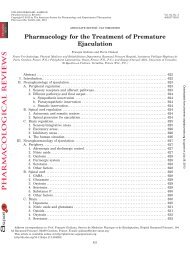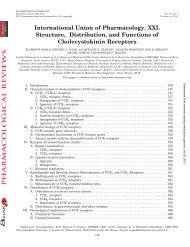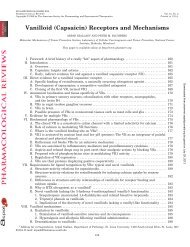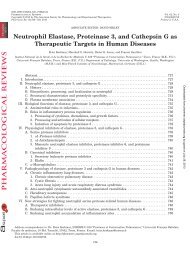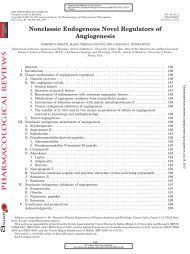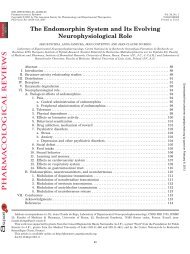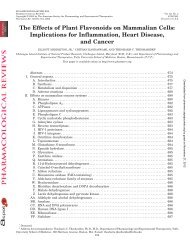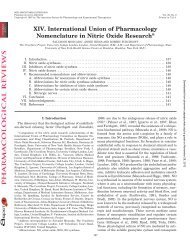Opioids, Reward and Addiction: An Encounter of Biology ...
Opioids, Reward and Addiction: An Encounter of Biology ...
Opioids, Reward and Addiction: An Encounter of Biology ...
You also want an ePaper? Increase the reach of your titles
YUMPU automatically turns print PDFs into web optimized ePapers that Google loves.
pituitary hormone -lipotropin (Bradbury et al., 1976). The<br />
C fragment, later termed -endorphin (from endogenous<br />
morphine), <strong>and</strong> the enkephalins were shown to induce<br />
similar actions as morphine in a number <strong>of</strong> in vitro <strong>and</strong> in<br />
vivo test procedures. Repeated administration <strong>of</strong> -endorphin<br />
led to tolerance to its analgesic action <strong>and</strong> to morphine-like<br />
withdrawal symptoms upon a challenge with<br />
naloxone (Van Ree et al., 1976; Wei <strong>and</strong> Loh, 1976). Furthermore,<br />
-endorphin <strong>and</strong> the enkephalins were self-administered<br />
by laboratory animals, indicating the rewarding<br />
properties <strong>and</strong> addictive potential <strong>of</strong> these substances<br />
(Belluzzi <strong>and</strong> Stein, 1977; Van Ree et al., 1979; Goeders et<br />
al., 1984). Thus, the endogenous opioids may share all its<br />
typical opioid-like actions with morphine, both after acute<br />
<strong>and</strong> chronic administration.<br />
After the discovery <strong>of</strong> another class <strong>of</strong> endogenous opioids,<br />
the dynorphins, (dyn.... from Greek dynamis <br />
power) (Goldstein et al., 1979, 1981), it appeared that most<br />
endogenous opioids are generated by enzymatic processing<br />
from three precursor molecules, pro-opiomelanocortin<br />
(POMC), 2 proenkephalin (ProEnk), <strong>and</strong> prodynorphin<br />
(ProDyn) (Nakanishi et al., 1979; Kakidani et al., 1982;<br />
Noda et al., 1982). Each <strong>of</strong> these precursors has an unique<br />
anatomical distribution throughout the central nervous<br />
system (CNS) <strong>and</strong> in peripheral organs (Akil et al., 1984;<br />
Khachaturian et al., 1985). The anterior <strong>and</strong> neurointermediate<br />
lobes <strong>of</strong> the pituitary gl<strong>and</strong> are major sites <strong>of</strong><br />
POMC biosynthesis. In the brain, there are two distinct<br />
nuclei that contain POMC neurons: the arcuate nucleus <strong>of</strong><br />
the hypothalamus <strong>and</strong> the nucleus tractus solitarius.<br />
Widespread projections from these neurons are present<br />
throughout the brain. From POMC the opioid -endorphin<br />
is generated, but also - <strong>and</strong> -endorphin <strong>and</strong> several<br />
nonopioid peptides, e.g., adrenocorticotropin <strong>and</strong> - <strong>and</strong><br />
-melanocyte-stimulating hormones. ProEnk-containing<br />
neurons are widely distributed throughout the brain <strong>and</strong><br />
consist <strong>of</strong> both local circuits <strong>and</strong> long projection neurons.<br />
ProEnk is the source <strong>of</strong> Leu- <strong>and</strong> Met-enkephalin <strong>and</strong><br />
several extended forms <strong>of</strong> these pentapeptides. ProDyncontaining<br />
cell bodies have a characteristic widespread<br />
distribution throughout the CNS. ProDyn-containing<br />
neurons have both short <strong>and</strong> long projection pathways <strong>and</strong><br />
2 Abbreviations: POMC, pro-opiomelanocortin; 5-HT, 5-hydroxytryptamine<br />
(serotonin); ICSS, intracranial electrical self-stimulation;<br />
6-OHDA, 6-hydroxydopamine; i.c.v. intracerebroventricular;<br />
AMPA, -amino-3-hydroxy-5-methylisoxazole-4-propionic acid; E-<br />
IR, -endorphin immunoreactivity; LAAM, l--acetylmethadol; LH,<br />
lateral hypothalamus; BNTX, 7-benzylidenenaltrexone; MFB, medial<br />
forebrain bundle; CCK, cholocystokinine; NAC, nucleus accumbens;<br />
CNS, central nervous system; NMDA, N-methyl-D-aspartate;<br />
CTOP, D-Phe-Cys-Tyr-D-Trp-Orn-Thr- Phe-Thr-NH 2; nor-BNI, norbinaltorphimine;<br />
DA, dopamine; ProEnk, pro-enkephalin; DAMGO,<br />
[D-Ala, N-Me-Phe 4 , Gly-ol 5 ]-enkephalin; PAG periaquaductal gray;<br />
DNQX, 6,7-dinitroquinoxaline-2,3-dione; ProDyn, pro-dynorphin;<br />
DPDPE, [D-Pen 2 , D-Pen 5 ]-enkephalin; TIQ, tetrahydroisoquinoline;<br />
VTA, ventral tegmental area; FR, fixed-ratio; HAD, high alcoholdrinking;<br />
AA, alko alcohol; DG-AVP, desglycinamide 9 -[Arg 8 ]-vasopressin.<br />
OPIOIDS, REWARD AND ADDICTION 343<br />
can generate several opioid peptides, including - <strong>and</strong><br />
-neoendorphin, dynorphin A, <strong>and</strong> dynorphin B.<br />
Martin et al. (1976) first postulated the existence <strong>of</strong><br />
multiple types <strong>of</strong> opioid receptors. Based on their behavioral<br />
<strong>and</strong> neurophysiological findings in the chronic spinal<br />
dog, they distinguished between the type (for morphine,<br />
which induces analgesia, hypothermia, <strong>and</strong> meiosis among<br />
others), the -type (for ketocyclazocine, which induces depression<br />
<strong>of</strong> flexor reflexes <strong>and</strong> sedation among others), <strong>and</strong><br />
-type (for SKF10,047 or N-allylnormetazocine, which induces<br />
tachycardia, delirium, <strong>and</strong> increased respiration<br />
among others). Later, a fourth type <strong>of</strong> opioid receptor,<br />
named (for vas deferens) was identified (Lord et al.,<br />
1977). Additional research revealed that the -type receptor<br />
is nonopioid in nature, leaving three main type <strong>of</strong> opioid<br />
receptors, , , <strong>and</strong> (Mannalack et al., 1986). These<br />
receptors, belonging to the family <strong>of</strong> seven transmembrane<br />
G protein-coupled receptors, have been cloned using molecular<br />
biological techniques (Evans et al., 1992; Kieffer et<br />
al., 1992; Reisine <strong>and</strong> Bell, 1993; Uhl et al., 1994; Knapp et<br />
al., 1995). Apart from occurring as separate molecules,<br />
brain - <strong>and</strong> -opioid receptors have also been suggested to<br />
function as a - receptor complex (for review, see Rothman<br />
et al., 1993). In slices <strong>of</strong> rat neostriatum, activation <strong>of</strong><br />
this complex, which displays an affinity pr<strong>of</strong>ile for opioid<br />
lig<strong>and</strong>s different from nonassociated - <strong>and</strong> -opioid receptors,<br />
has been shown to inhibit dopamine (DA) D1-receptor-stimulated<br />
adenylate cyclase activity (Sch<strong>of</strong>felmeer et<br />
al., 1992, 1993).<br />
Interestingly, there seems to be some preference for the<br />
different endogenous opioid lig<strong>and</strong>s for the different receptors:<br />
-endorphin for , enkephalins for , <strong>and</strong> dynorphins<br />
for . Subtypes <strong>of</strong> these receptors have been proposed<br />
( 1, 2; 1, 2; 1, 2, 3) (Dhawan et al., 1996) <strong>and</strong> some<br />
evidence is available for some other receptor types [e.g., the<br />
receptor which was labeled as -endorphin specific<br />
(Wüster et al., 1979; Narita <strong>and</strong> Tseng, 1998)]. The International<br />
Union <strong>of</strong> Pharmacology subcommittee on opioid<br />
receptors has proposed another terminology to distinguish<br />
the opioid receptors: OP1, OP2, <strong>and</strong> OP3 for the , , <strong>and</strong> <br />
receptor, respectively (Dhawan et al., 1996) (Table 1). <strong>An</strong>other<br />
opioid-like receptor has been cloned, termed the<br />
ORL-1 opioid receptor (Fukuda et al., 1994; Mollereau et<br />
al., 1994; Lachowitz et al., 1995). In addition, some novel<br />
endogenous opioids have been isolated, termed orphanin<br />
FQ which seems to be an endogenous lig<strong>and</strong> for ORL-1 <strong>and</strong><br />
endomorphin-1 <strong>and</strong> endomorphin-2 which have been pro-<br />
TABLE 1<br />
Nomenclatures <strong>of</strong> opioid receptors (IUPHAR recommendations)<br />
Preferential<br />
Endogenous<br />
Opioid<br />
Lig<strong>and</strong>s<br />
IUPHAR<br />
Recommendation<br />
Opioid Receptors<br />
Pharmacology<br />
Nomenclature<br />
Molecular <strong>Biology</strong><br />
Nomenclature<br />
Enkephalins OP1 DOR<br />
Dynorphins OP2 KOR<br />
-endorphin OP3 MOR<br />
See Dhawan et al. (1996).



